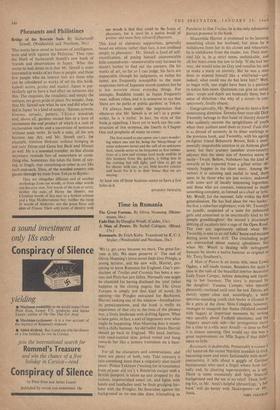Pheasants and Philistines
Bridge of the Brocade Sash. By Sacheverell Sitwell. (Weidenfeld and Nicolson, 36s.)
'His works have stood as bastions of intelligence, taste and style against the Philistine.' Thus runs the blurb of Sacheverell Sitwell's new book of `travels and observations in Japan.' What this seems to boil down to is that Mr. Sitwell is more interested in works of art than in people; and those few people who do interest him are those who can be considered as works of art (in this book. kabuki actors, geisha and maiko). Japan is par- ticularly apt to have a bad effect on someone like this. The exquisite, the ritualistic, and simply the antique, are given pride of place. No wonder, then, that Mr. Sitwell saw what he saw and did what he did in Japan 'in a kind of ecstasy.' Statues, screens, kimono, netsuke, pottery, Ukivo-e woodcuts and, above all, gardens roused him to a state of excitement the end product of which is a rash of exclamation marks and a succession of sentences without main verbs. In such a state, all the arts become one Art, and Mr. Sitwell can't, for example, mention Hokusai without bringing in not only Darer and Goya but Bach and Mozart as well. He is a seasoned traveller, so that almost anywhere reminds him of somewhere or some- thing else. Sometimes this takes the form of say- ing, at length, that something-or-other is not like such-and-such. Thus, of the wooded country one passes through by train from Tokyo to Kyoto: They are altogether different and of another
mythology from our woods, or from other woods one has ever seen. Not woods of the faun or satyr; neither the oaks of Herne the Hunter, nor Claudian woods of ilex near to a broken column and a blue Mediterranean bay; neither the steep fir woods of Altdorfer, nor the green limes and elms of France. Their only point of identity with
our woods is that they could be the haunt of pheasants, but it must be a native breed of
greener and more fiery coloured pheasants.
This kind of elaborate supposition, generally based on whimsy rather than fact, is not confined simply to pheasants : Mr. Sitwell is fond of self- mystification, of posing himself unanswerable little conundrums—unanswerable only because he doesn't bother to find out the answers. On his works of art, so far as I can judge, his facts are impeccable (though his judgments, or rather his tastes, are frequently susceptible to the most suspicious sorts of Japanese mumb-jumbo), but he is less accurate about everyday things. For example, Buddhist monks in Japan frequently wear saffron robes, and it is nonsense to say that 'there are no parks or public gardens' in Tokyo.
I'd always been under the impression that whatever else. Mr. Sitwell is or isn't as a proSe- writer, he is 'a stylist.' In fact, the style of this book js appalling. I have yet to work out the con- struction of this sentence, the fourth in Chapter One and prophetic of many to cone: The first sound as one opens one's eyes wonder- ing where one can be, being the 'bleep-bleep' of some unknown insect and the call of an unknown bird, sounds never to be forgotten as first intima- tions of a new and strange land made audible in this moment from the garden, it being late in the evening but still light, and time to get up for dinndr with our, as yet, little known cousins and hosts for it is in their house that we are staying.
At least one of those bastions seems to have a few holes in it.
ANTHONY THWAITE






































 Previous page
Previous page